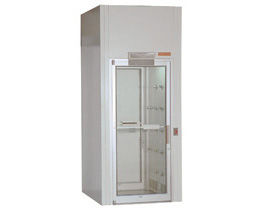Air Showers for Grow Rooms

Prevent Cross Contamination of Spores and Mildew
Fungi cause many problems in grow rooms, specifically powdery mildew and bud rot. Because mold spores often cling to garments as workers pass by, an air shower provides a last barrier against spores which originate from outside the grow room. Also referred to as “air locks”, these corridors serve as additional measures against mold spores and insects.
How Does an Air Shower Work?
Air showers feature high pressure air jets which induce a flapping effect on clothing, thus vigorously shaking and expelling particles, including those derived from humans (cells, dandruff, mucous), while also combating mites, pollen, and fungal spores. They feature a standard HEPA filter which capture 99.99% of spores, bacteria, and pathogens at 0.3 micron or larger. The operator steps into one side of the shower, which automatically seals the other side to create an air barrier. Upon entry, all the air in the corridor is evacuated, HEPA filtered, and then recirculated.
Air Shower Advantages for Cannabis Grows
Reduce Trace Moisture in Cracks and Crevices
Air showers help evaporate water in the crevices of transport carts, crates, or stacked items such as pots and bags. Particularly, reducing moisture on wheels or contact services helps keep the facility cleaner and reduce floor cleaning labor.
Pass-Through for Large Items
Most cannabis facilities prefer large air showers, as transport carts and pallet jacks are often required at the beginning and end of grow cycles. Large items like carts or shelving have many crevices and cracks which harbor debris, spores, and plant material. Extra large pass-through air showers allow the passage of pallets, soil bags, pots, carts, and other large items.
Prevent Mold and Fungus Spores
Air currents are the primary method of distribution and procreation for mold spores. Mold spores are small, generally between 0.3 - 100 microns. Small particles become buoyant and stay airborne for much longer than larger particles, sometimes up to 48 hours. It would not be unusual for mold spores to be carried from general working areas or corridors near outside entrances.
Reduce Spider Mites and Insects
"Air lock entrances with interlocking doors are useful not only for controlling access to the facility via key cards, but also serve as an additional control for highly mobile insect vectors. The vestibule at the entrance to a growth room can be enhanced to prevent vector entry or escape by the use of high temperatures, or controlled lighting so that the vestibule is always darker than the containment room thus discouraging insect egress due to light attraction." - Plant Biotechnology Journal
Maintain Tighter Control of Air Pressure
When a door is opened, air exchange and pressure equalization results in turbulence and air jet streams. In negative pressure grow rooms, dirty and unconditioned air from outside spaces is constantly sucked into the grow room. This not only allows the possibility for opportunistic spores, but also influences temperature variation in the grow room, and therefore humidity levels.
Depending on how many people enter and exit the room, how large the doorway is, and what the difference between ambient pressure is between adjacent rooms, the impact on grow room climate varies between subtle and dramatic.
Reduce Temperature Changes
Indoor-outdoor temperature difference is a dominating factor when calculating air exchange rates. The air change rate, also referred to as ACR, is an indicator of how quickly a room introduces pre-conditioned air from a heater or air conditioner, and how fast it exhausts the air.
Anyone who has sat next to an outside entry during winter months knows that constant influx of cold air turns an otherwise well insulated room into a dry freezer.
Stabilize Humidity
Uncontrolled air flow not only influences the physical dynamics of air throughout the canopy, but also the makeup and temperature of the air. Depending on the placement of your hygrometer probes, these variances may over/under exaggerate the compensation to achieve ideal temperature and humidity. A greater degree of control over air inputs and outputs ultimately help the grower make better evaluations and adjustments than do rooms with unpredictable and aggressive air flow patterns.
Popular Air Shower Designs for Grow Rooms

Standard Air Showers
Air showers quickly and effectively remove particles so that they will not be carried into your cleanroom. These decontamination air showers feature rugged construction and adjustable, high velocity air jets.

Low-Profile Air Showers
Low-profile air showers have a side-mounted blower assembly, HEPA filter and electrical components, making them ideal for retrofits or where ceilings can’t be penetrated.

Pass-Through Air Showers
Pass-Through Air Showers offer an effective way to remove surface-deposited particles from large materials as you transfer them into the clean room. They can be used with carts, conveyors, pallets and continuous-part operations.
